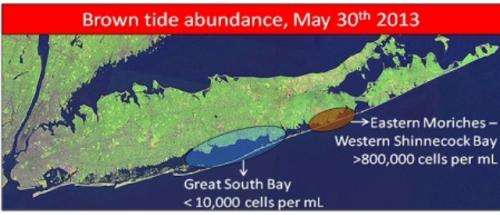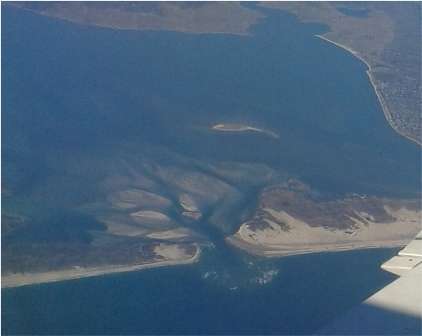Presence of new ocean inlet in Great South Bay may help keep brown tide in check

A brown tide has emerged within some, but not all, of Long Island's south shore estuaries. Monitoring by the Gobler Laboratory in the Stony Brook University School of Marine and Atmospheric Sciences has revealed that a brown tide has developed in eastern Moriches Bay, Quantuck Bay, and western Shinnecock Bay.
Abundances of the brown tide organism in this region progressively increased through the month of May and were recorded at maximal densities of more than 800,000 cells per milliliter in western Shinnecock Bay as of June 1st. Densities above 50,000 cells per milliliter can be harmful to marine life.
The brown tide alga, Aureococcus anophagefferens, has been notorious on Long Island since it first appeared in 1985 having been responsible for the demise of the largest bay scallop fishery on the US east coast in the Peconic Estuary, the loss of eelgrass across Long Island, and the inhibition of hard clam recovery efforts in Great South Bay. This marks the seventh consecutive year these destructive blooms have occurred in the Moriches-Quantuck-Shinnecock Bay system. While brown tides have also occurred in Great South Bay as recently as 2008 and 2011, the presence of a new ocean inlet in eastern Great South Bay that formed during Hurricane Sandy may be assisting in keeping the blooms away in 2013.
Dr. Christopher Gobler, a Professor within Stony Brook University's School of Marine and Atmospheric Sciences whose laboratory generated the brown tide data, indicated that the distribution of this year's brown tide comes as good news to some and bad news to others.
"The absence of a brown tide in Great South Bay may be a 'Gift from Sandy'," Gobler said. "Since the new inlet was created following the Hurricane Sandy, we've seen higher salinity, lower chlorophyll, lower nitrogen, and stronger flushing in eastern Great South Bay. The inability of the brown tide organism to form a bloom in this region is consistent with these conditions and should help promote the growth of hard clams and eelgrass in this bay."

The news for the eastern regions of the Long Island's south shore was not as good.
"The combination of poor flushing and intensive nitrogen loading into the eastern Moriches-western Shinnecock Bay region makes it highly vulnerable to algal blooms," said Gobler. "We had hoped that the cooler spring and the efforts of the Shinnecock Bay Restoration Program to restock filter feeding shellfish in the Bay might restrict this year's bloom. We are still hopeful that these filter feeders may make this year's bloom less intense in this region than it has been in recent years", said Gobler noting that in 2011 and 2012, cell densities of the brown tide were more than twice as dense as the current bloom at two million cells per milliliter.
Provided by Stony Brook University



















